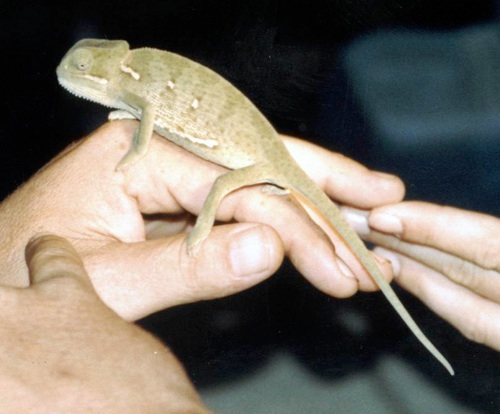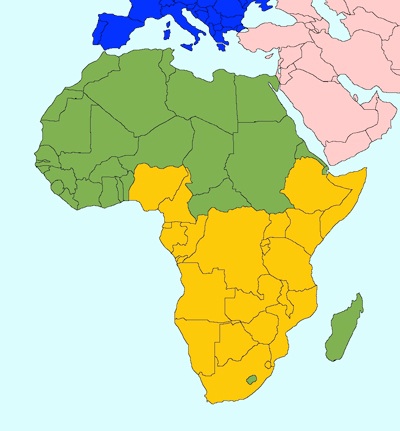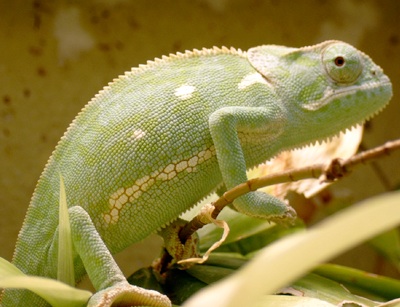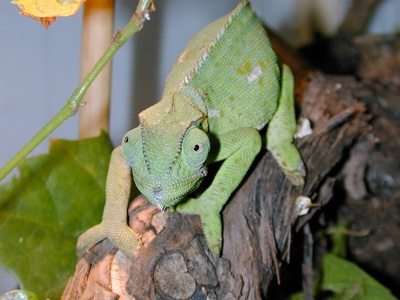



Chamaeleo dilepis Complex
By Steven Deckers
Citation:
Deckers, S. (2006). Chamaeleo dilepis complex. Chameleons! Online E-Zine, September 2006. (http://www.chameleonnews.com/06SepDeckers.html)
Animals from the Chamaeleo dilepis complex have a large distribution area ranging from the Southern Sahara border and Nigeria to northern South Africa. Currently research giving a clear picture of this species complex is lacking, to the best of my knowledge. The Ch. dilepis complex includes the following species and subspecies:
-
•Ch. dilepis dilepis
-
•Ch. dilepis idjwiensis
-
•Ch. dilepis isabellinus
-
•Ch. dilepis martensi
-
•Ch. dilepis petersii
-
•Ch. dilepis ruspolii
-
•Ch. roperi
-
•Ch. quilensis

Quilenses, South Africa

Appearance:
Members of the dilepis complex can become from 20 to 40 cms long. In general females grow larger then the males with general morphology being rather typical of a basic chameleon. All species and subspecies have an enlarged casque and occipital lobes. The form and size of the casque and lobes and the location where lobes attach to the casque differ between species and subspecies. Further, the males of some species and subspecies have tarsal spurs on the hind legs, similar to male Chamaeleo calyptratus. These spurs have an average size of 1 - 4 mm in adults, depending on subspecies.
The base coloration of the members of this complex is green but they can have many more colors: yellow, black, orange, white and brown. The coloration and pattern the animals show depends on their state of mind, health and the seasonal environmental differences. All species of the dilepis complex have a lateral stripe, which is generally colored white. This stripe extends from the back of the head to the end of the body. Above this stripe, many species have a second line. This second line never goes over the total length of the body and is often interrupted at one or more places along its length. This line starts behind the head and almost never goes further then half of the body length.
Subspecies:
Over the last couple hundred years, several species and subspecies that fall into this group have been described. Some of these have changed names several times. At this time some of the formal subspecies are seen as their own species while information on other subspecies is quite limited. The following information on subspecies and species differences is based on review of various resources:
Ch. dilepis dilepis
This subspecies lives across the area from the Sahara to northern South Africa. The males from this subspecies have tarsal spurs and both sexes have large occipital lobes. In general this is one of the largest sub-species.

Ch. dilepis dilepis Male - Photo curtesy of Brandy Snow

Ch. dilepis dilepis Female - Photo curtesy of Brandy Snow
Ch. dilepis idjwiensis
This species lives in Rwanda, Burundi, Uganda and eastern Zaire and lacks tarsal spurs.
Ch. dilepis isabellinus
This subspecies is native to the malawi highlands.
Ch. dilepis martensi
This subspecies lives on the Pembla Island in Tanzania.
Ch. dilepis petersii
This subspecies comes from Mozambique and southern Tanzania and have tarsal spurs.
Ch. dilepis ruspolii
This subspecies lives in Somalia and Ethiopia.
Ch. roperi
The distribution for this species is mainly Kenya but also extends into Zaire, Tanzania and Angola. They lack tarsal spurs.
Ch. quilensis
The distribution of this species is almost the same as Ch. dilepis dilepis. This species has tarsal spurs but unlike Ch. d. dilepis, they have small occipital lobes.

quilensis male

quilensis female
There is a high likelihood of further taxonomical revision of the dilepis group. Some of the actual subspecies could then become separate species and some of the other subspecies could be seen as synonyms of what is now Ch. dilepis dilepis or one of the other subspecies. Much of the information is limited at this time as some of the descriptions are based on one single animal. Internal morphology, such as hemipenal structure, shows clear differences between some species such as dilepis and quilensis.
All names used in the remainder of this article is based on my interpretation of any literature I have.
Experiences with Chamaeleo quilensis
In 2000 I bought my first two “dilepis” specimens. At the time, I wasn’t really familiar with the taxonomic complexity of the dilepis group. Knowing what I know now, I’d classify these specimens as Ch. quilensis. They where wild caught animals from Tanzania and had just arrived in the country with approximately 20 other “dilepis”. Unfortunately, only 3 of these imports appeared to be in good health. In looking at all animals, I noticed a big difference in size, not only in the body but also in occipital lobes. From the 3 healthy animals, 2 looked the identical.
All three specimens where females in early stages of pregnancy. Among the other animals brought in, I didn’t see any males. I decided to take the risk and bought 2 females, in the hope I’d be able to buy a male later on.
At home I put both animals in their own cages. The cages where round and, except the top and bottom, made from gauze. Each enclosure was 1.2 meters high and 60 cm in diameter. At the bottom I had 20 - 30 cm of a sand and dirt mix.
The first thing I did after they where put in their cage was mist them. After this I immediately tried to give them water with a pipette. One of the animals started drinking from the pipette right away but the other one never did. With fresh imports, the most important requirement is water. Food can wait a while but failure to rehydrate the animals can be fatal. The second day I started feeding the animals both ate right away.
The first two weeks passed without any problems. After a couple weeks, one of the females ate much less as before. At first I worried about what the problem was but fortunately it was the normal decrease in appetite they have before laying eggs. After a few days the female laid her 28 eggs without any problems. In the next two weeks the same story repeated itself with the second, smaller, female. She also laid her 24 eggs without problems.
The female who laid her eggs first recovered very well and started eating and drinking almost immediately. The other female unfortunately didn’t recover well and eventually died three weeks later. A necropsy discovered that an egg had failed to detach from the ovary correctly, causing her death. Other chameleon keepers told me this was a known problem with dilepis, but after this case, I never witnessed it again.
When searching information about incubating the eggs I found a lot of different information. The incubation temperatures varied between 20 and 28 degrees Celsius and the incubation time varied from 120 to 360 days. After considering the value of each information source, I decided to place the eggs with a temperature of 28 in the incubator. If I needed to make the same choice again for eggs of a new species, I would generally choose a lower temperature. As far as I know now, however, these high temperatures never had a negative effect on eggs.
I lost two eggs in the first two weeks and the remainder developed without any problems. After 4 months I started checking the eggs thinking they could possibly start hatching. It was the end of August and there was a heat wave in The Netherlands. Due to this heat wave, I had trouble keeping my incubator at 28 degrees and the temperatures increased to 28.5 - 29 degrees. I was afraid the higher temperatures would have a negative effect on my eggs, but after two days I found my first neonate from this clutch and after 8 days, all the neonates hatched although 3 eggs didn’t hatch. All the neonates where very active and started eating and drinking almost immediately.
With the other clutch was still in the incubator, the temperature dropped to the normal temperature of 27.5 – 28 degrees. After four weeks the first neonates from this clutch started to hatch. These neonates where not as active as the last clutch, however. Further, they didn’t hatch as closely together as the first clutch. When ten neonates had been born, I started to wonder what went different with these eggs compared with the other ones and the only difference I could think of was the temperature change during the heat wave. I decided to raise the temperature in the incubator by one degree. After I did so, 12 healthy neonates where born.
Some literature recommended raising the neonates singly in small terrariums but I decided to keep them in groups of 5 animals in terrariums of 25x40x60 cm (width x length x height). I choose a plant with very small leaves and which could stay moist. Further I added some extra branches so the juveniles had sufficient climbing space.
The juveniles combined based on size and they were fed fruit flies, houseflies and crickets. Their growth over the first three months was rapid and the average total size of the juveniles at this stage was 11 - 14 cm. Keeping the juveniles together up to this point hadn’t been a problem. As long as enough food was available, I didn’t notice any aggression.
At the age of 3 months, it was still very difficult to determine the sex of the juveniles. Males didn’t have an enlarged tail base as in some other species and spurs weren’t visible. I decided it was time to give away some of the juveniles and after hearing from the Dutch chameleon society (Kameleon vereniging Nederland KVN) that there was no information of any successful breeding of this species. As a result, I decided to give away 15 animals to different members so we could spread the chance for any loses. I kept 5 animals for myself and the other animals where sold.
Of the 20 animals in the Chameleon society there were only 3 males and unfortunately, I had 5 females. For various reasons, all the animals in other hands died and there was no male left to mate with my females. In the mean time I was hoping for a new Tanzania shipment to buy a new male but in all shipments that came in, I hadn’t found a single male matching my animals.
With so many different subspecies being offered and in so many different sizes, it was almost impossible to start a good group. For this reason, I believe that is it best to buy a good sized breeding group at the start so you’ll not have to depend on being able to locate similar animals down the road.
In my attempts to get a male Ch. quilensis I have placed multiple orders and reservations. In the end, I got two more females, 1.3 Ch. gracilis, 1.2 of an unknown species and 1.2 Ch. dilepis petersii. Once I was sure the gracilis and the unknown species where healthy, I gave them away as this where not the species I was interested in.
In my second attempt with the two new females 1 female died soon after acquisition and the second female laid a good clutch and recovered very well. I raised the juveniles almost the same as the first time. The only difference was that I gave them a larger variation in food items.
This second time I though to be smarter and I decided to keep more animals for a longer time so I could get a male and search for unrelated females afterwards. Finally I had one beautiful male. Unfortunately, he acquired a hemipenal prolapse and died before he could breed with my females. I finally gave my last females to another dilepis enthusiast who thought they could find a mate for them.

Ch. d. petersii
When I ordered Ch. quilensis for the last time I got 1.2 Ch. dilepis petersii instead of Ch. quilensis. The male was still very young and one of the females seemed to be pregnant. This seemed to be a good chance to start up a little breeding group and I decided to keep these animals, although they where not quilensis. As they where wild caught animals and I wasn’t completely sure if they were pregnant or not, I placed both females in terrariums with places to lay eggs.
The male and pregnant female both drank and ate very well but unfortunately, the other female didn’t adept very well. She only drank and ate every now and then and she died after 6 weeks for undetermined reason. The remaining female laid 19 eggs at a depth of 15 cm after 3 weeks.

After my experiences with Ch. quilensis, I decided to incubate these eggs at 28 degrees as well. With a lot of bad luck my incubator broke 3 times during the incubation of these eggs causing a temperature variation between 24 and 33 degrees. After 8 months 11 from the 19 eggs hatched in a time period of almost 45 days.
Most of the juveniles where alert and active in the first weeks. But I never saw them eat or drink. After two weeks I saw the first juveniles dying and the other juveniles looked to be in bad condition. After 5 weeks only one juvenile was left. This last one did eat and drink but the growth was very slow.
When the last juvenile was about 8 weeks old I got a nice surprise one morning. I was in a hurry and was misting my animals quickly but Isaw something crawling in a terrarium where at that time I wasn’t keeping chameleons at all. This was the enclosure where I kept the other female that died after 6 weeks. Since that time there hadn’t been any other chameleons in this terrarium. In total I found 18 eggs in the enclosure.
These juveniles where much more alert and active then the first ones. They ate and drank very well on a diet of fruit flies and roaches. I kept them identically to the quilensis juveniles and when the animals reached the age of 4 months, all 18 where still alive. While they didn’t grow as fast as quilensis, this species doesn’t seem to get as large and is from another area which may account for the variation.
The terrariums I kept the males in were 60x50x60 cm. (width x length x height) and the cages for the females were 40x60x110 cm. The bottom 30 cm of the female’s enclosures were soil for egg oviposition. The terrariums of the males were primarily made of glass with the top and a portion of the front made of gauze. The enclosures for the females were totally made of gauze except the lower 40 cm to contain the soil.
I used two sized enclosures for the juveniles. For small specimens, I used an enclosure that measured 25x40x60 cm and for the larger ones, an enclosure measuring 40x40x60 cm. These terrariums where made with the top, sides and part of the front made with gauze.
For chameleons, I generally provide three kinds of lighting: Daylight, UV light and heating lamps.
For UV I use PL lamps from the Radium Ralutec brand. These lamps give relatively small amounts of UV and only on a short distance. Because I place the lamps close to the heating spots, my animals get UV light in the morning when they come under the lamps to heathen. I’ve been using these lamps for over 5 years now without any problems.
For heating I use halogen lamps as I think these lamps have some benefits over regular spots. They use far less power and they direct their warmth and light in one direction, making sure I don’t use valuable energy. Further, halogen lamps give off a lot of light but there heat doesn’t radiate as far as regular spots. This helps ensure that the enclosure experiences a gradient. I dim the halogen lamps so a basking spot of 35 degrees Celsius is provided.
For daylight I also use PL lamps. With these I choose the most natural of the three different colors.
For each terrarium, the total wattage used is as follows:
UV light: 7 or 11 Watts
Halogen light: 10,20 or 50 Watts (juveniles, sub-adults, adults)
Daylight: 5,7,9 or 11 Watts, depending on cage size.
As with most chameleons I have experience with, Ch. dilepis complex members seem to prefer flying prey items. They also seem to love to eat roaches and wood louse over crickets. Their total food variety from me included:
-
•Fruit flies
-
•“Curled flies”
-
•Crickets
-
•Roaches
-
•Wood louse
-
•Grasshoppers
-
•Super worms
-
•Wax moths larvae
-
•Beetle larvae
-
•caterpillar
For hydration, I misted adults heavily every morning and sometimes in the evening while the juveniles where misted twice a day.
The biggest problems I had with keeping members of the Ch. dilepis complex was finding a good and healthy group of animals. There is enough wild caught but good offspring is rare. Wild caught are often of different subspecies in one shipment, so one should be very careful to search for animals of the same specie.
Also the survival rate of wild caught dilepis in my experience was lower then with many other species. They seem to carry more parasites then other species and most animals also look dehydrated when they come in. In contrast to many other species, more females then males seem to come in on shipments, in my experience.
One major issue I found while working with this complex was that a lot of people claim to prefer to buy captive bred offspring over wild caught animals. When offering captive bred dilepis, however, interest seems far more limited due to the inexpensive availability of wild caught animals. As a result of the problems I encountered in creating a healthy breeding group and the low request for juveniles caused me to stop working with this species temporarily. I hope, however, that more individuals will become interested in working with this complex and a demand for captive bred specimens will result.

Steven Deckers

Steven Deckers is a 22 year old chameleon keeper from The Netherlands. He has been keeping chameleons for approximately 7 years. He has bred a number of species over the years and considers those from the African mainland to be his favorite.









Join Our Facebook Page for Updates on New Issues:
© 2002-2014 Chameleonnews.com All rights reserved.
Reproduction in whole or part expressly forbidden without permission from the publisher. For permission, please contact the editor at editor@chameleonnews.com
